ISW Blog
-
ISW Blog - 23:41 Oct 05, 2022
 Kitaneh Fitzpatrick, Nicholas Carl, Zachary Coles, and Frederick W. Kagan October 5, 3:00 PM The Iran Crisis Updates are produced by the Critical Threats Project (CTP) at the American Enterprise Institute with support from the Institute for the Study of War (ISW). To receive Iran Crisis Updates via email, please subscribe here. Anti-regime protests seemingly subsided in extent and size on October 5. October 5 marks the death of a prominent Shia Imam and is a national holiday in Iran, possibly explaining the decrease in protest activity in Iranian high schools. The regime’s ongoing internet and telecommunication restrictions are likely limiting the open-source information available on anti-regime demonstrations. Key Takeaways Anti-regime protests may have occurred in at least four cities in four provinces—a significant decrease from the previous day’s protest activity. Anti-regime outlet Iran International reported that Iran is using orbit jamming to block the network’s satellite signal into Iran. The Islam...
Kitaneh Fitzpatrick, Nicholas Carl, Zachary Coles, and Frederick W. Kagan October 5, 3:00 PM The Iran Crisis Updates are produced by the Critical Threats Project (CTP) at the American Enterprise Institute with support from the Institute for the Study of War (ISW). To receive Iran Crisis Updates via email, please subscribe here. Anti-regime protests seemingly subsided in extent and size on October 5. October 5 marks the death of a prominent Shia Imam and is a national holiday in Iran, possibly explaining the decrease in protest activity in Iranian high schools. The regime’s ongoing internet and telecommunication restrictions are likely limiting the open-source information available on anti-regime demonstrations. Key Takeaways Anti-regime protests may have occurred in at least four cities in four provinces—a significant decrease from the previous day’s protest activity. Anti-regime outlet Iran International reported that Iran is using orbit jamming to block the network’s satellite signal into Iran. The Islam... -
ISW Blog - 02:50 Oct 05, 2022
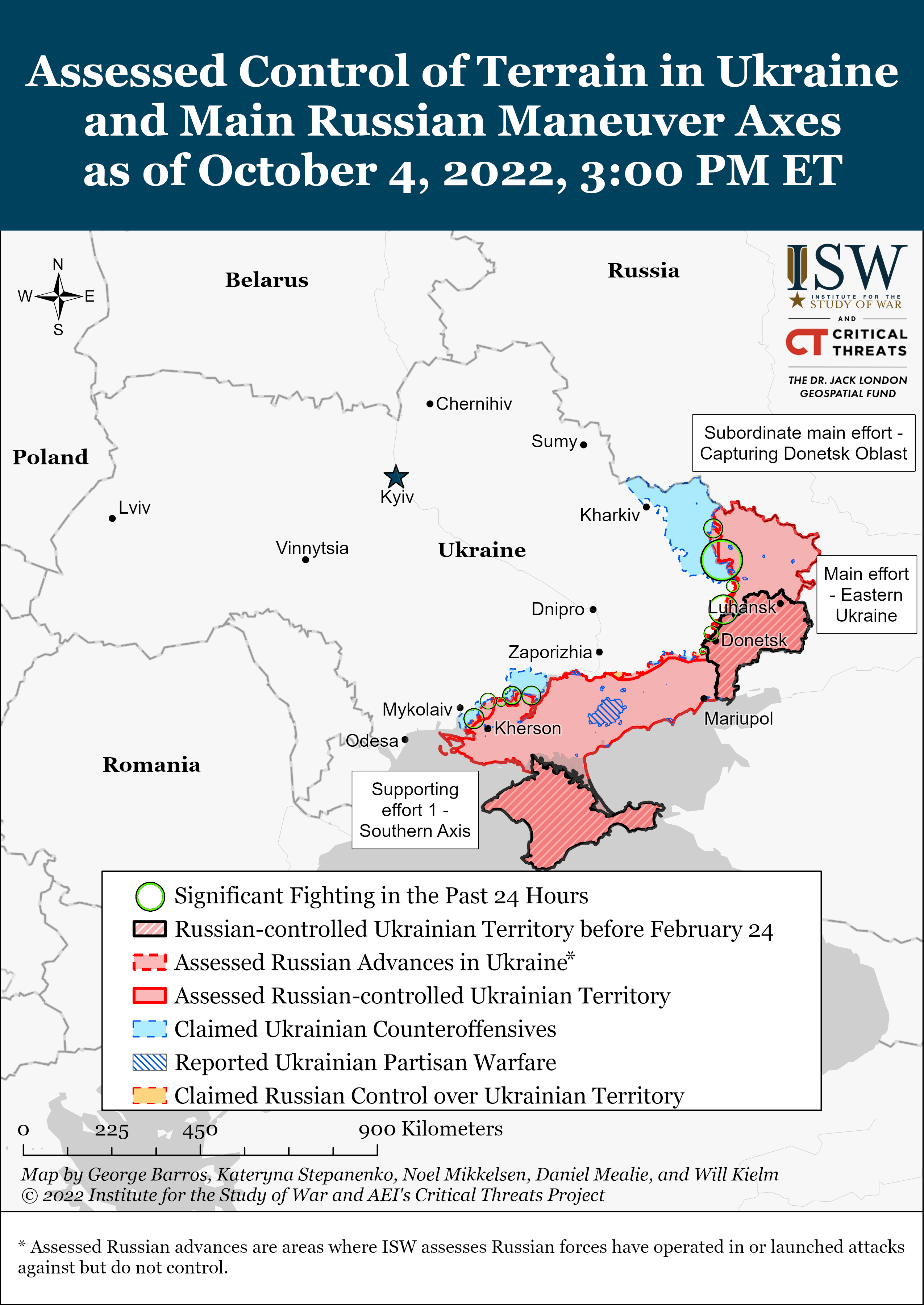 Kateryna Stepanenko, Karolina Hird, Katherine Lawlor, Riley Bailey, Grace Mappes, and Frederick W. Kagan October 4, 10:00 pm ET Click here to see ISW’s interactive map of the Russian invasion of Ukraine. This map is updated daily alongside the static maps present in this report. Ukrainian forces continued to make significant gains in Kherson Oblast while simultaneously continuing advances in Kharkiv and Luhansk oblasts on October 4. Ukrainian forces liberated several settlements on the eastern bank of the Inhulets River along the T2207 highway, forcing Russian forces to retreat to the south toward Kherson City. Ukrainian forces also continued to push south along the Dnipro River and the T0403 highway, severing two Russian ground lines of communication (GLOCs) in northern Kherson Oblast and forcing Russians south of the Kherson-Dnipropetrovsk Oblast border toward the Beryslav area. Ukrainian military officials noted that the Ukrainian interdiction campaign is crippling Russian attempts to transfer additional a...
Kateryna Stepanenko, Karolina Hird, Katherine Lawlor, Riley Bailey, Grace Mappes, and Frederick W. Kagan October 4, 10:00 pm ET Click here to see ISW’s interactive map of the Russian invasion of Ukraine. This map is updated daily alongside the static maps present in this report. Ukrainian forces continued to make significant gains in Kherson Oblast while simultaneously continuing advances in Kharkiv and Luhansk oblasts on October 4. Ukrainian forces liberated several settlements on the eastern bank of the Inhulets River along the T2207 highway, forcing Russian forces to retreat to the south toward Kherson City. Ukrainian forces also continued to push south along the Dnipro River and the T0403 highway, severing two Russian ground lines of communication (GLOCs) in northern Kherson Oblast and forcing Russians south of the Kherson-Dnipropetrovsk Oblast border toward the Beryslav area. Ukrainian military officials noted that the Ukrainian interdiction campaign is crippling Russian attempts to transfer additional a... -
ISW Blog - 22:08 Oct 04, 2022
 Nicholas Carl, Zachary Coles, and Frederick W. Kagan October 4, 3:00 pm ET The Iran Crisis Updates are produced by the Critical Threats Project (CTP) at the American Enterprise Institute with support from the Institute for the Study of War (ISW). University and high school students have begun largely leading the ongoing protest movement in Iran—at least for the moment. Anti-regime protests occurred in at least 17 cities in 14 provinces on October 4, primarily around universities and high schools. Students expressed frustration with the regime and Supreme Leader Ali Khamenei. The student protesters are a generation younger than the youth who played a prominent role in the Green Movement in 2009, during which Iranians took to the streets to protest the fraud-plagued reelection of then-President Mahmoud Ahmadinejad. These protests will likely influence this younger generation’s formative years in a fashion similar to the way the Green Movement affected the Iranian youth at the time. It will be interesting to obs...
Nicholas Carl, Zachary Coles, and Frederick W. Kagan October 4, 3:00 pm ET The Iran Crisis Updates are produced by the Critical Threats Project (CTP) at the American Enterprise Institute with support from the Institute for the Study of War (ISW). University and high school students have begun largely leading the ongoing protest movement in Iran—at least for the moment. Anti-regime protests occurred in at least 17 cities in 14 provinces on October 4, primarily around universities and high schools. Students expressed frustration with the regime and Supreme Leader Ali Khamenei. The student protesters are a generation younger than the youth who played a prominent role in the Green Movement in 2009, during which Iranians took to the streets to protest the fraud-plagued reelection of then-President Mahmoud Ahmadinejad. These protests will likely influence this younger generation’s formative years in a fashion similar to the way the Green Movement affected the Iranian youth at the time. It will be interesting to obs... -
ISW Blog - 02:17 Oct 04, 2022
 Karolina Hird, Kateryna Stepanenko, Riley Bailey, Katherine Lawlor, and Frederick W. Kagan October 3, 9 pm ET Click here to see ISW’s interactive map of the Russian invasion of Ukraine. This map is updated daily alongside the static maps present in this report. Ukrainian forces continued to make substantial gains around Lyman and in Kherson Oblast in the last 48 hours. Ukrainian and Russian sources reported that Ukrainian troops made significant breakthroughs in northern Kherson Oblast between October 2 and 3.[1] Geolocated footage corroborates Russian claims that Ukrainian troops are continuing to push east of Lyman and may have broken through the Luhansk Oblast border in the direction of Kreminna.[2] As ISW has previously reported, the Russian groupings in northern Kherson Oblast and on the Lyman front were largely comprised of units that had been regarded as among Russia’s premier conventional fighting forces before the war.[3] Elements of the 144th Motorized Rifle Division of the 20th Combined Arms Army r...
Karolina Hird, Kateryna Stepanenko, Riley Bailey, Katherine Lawlor, and Frederick W. Kagan October 3, 9 pm ET Click here to see ISW’s interactive map of the Russian invasion of Ukraine. This map is updated daily alongside the static maps present in this report. Ukrainian forces continued to make substantial gains around Lyman and in Kherson Oblast in the last 48 hours. Ukrainian and Russian sources reported that Ukrainian troops made significant breakthroughs in northern Kherson Oblast between October 2 and 3.[1] Geolocated footage corroborates Russian claims that Ukrainian troops are continuing to push east of Lyman and may have broken through the Luhansk Oblast border in the direction of Kreminna.[2] As ISW has previously reported, the Russian groupings in northern Kherson Oblast and on the Lyman front were largely comprised of units that had been regarded as among Russia’s premier conventional fighting forces before the war.[3] Elements of the 144th Motorized Rifle Division of the 20th Combined Arms Army r... -
ISW Blog - 02:15 Oct 04, 2022
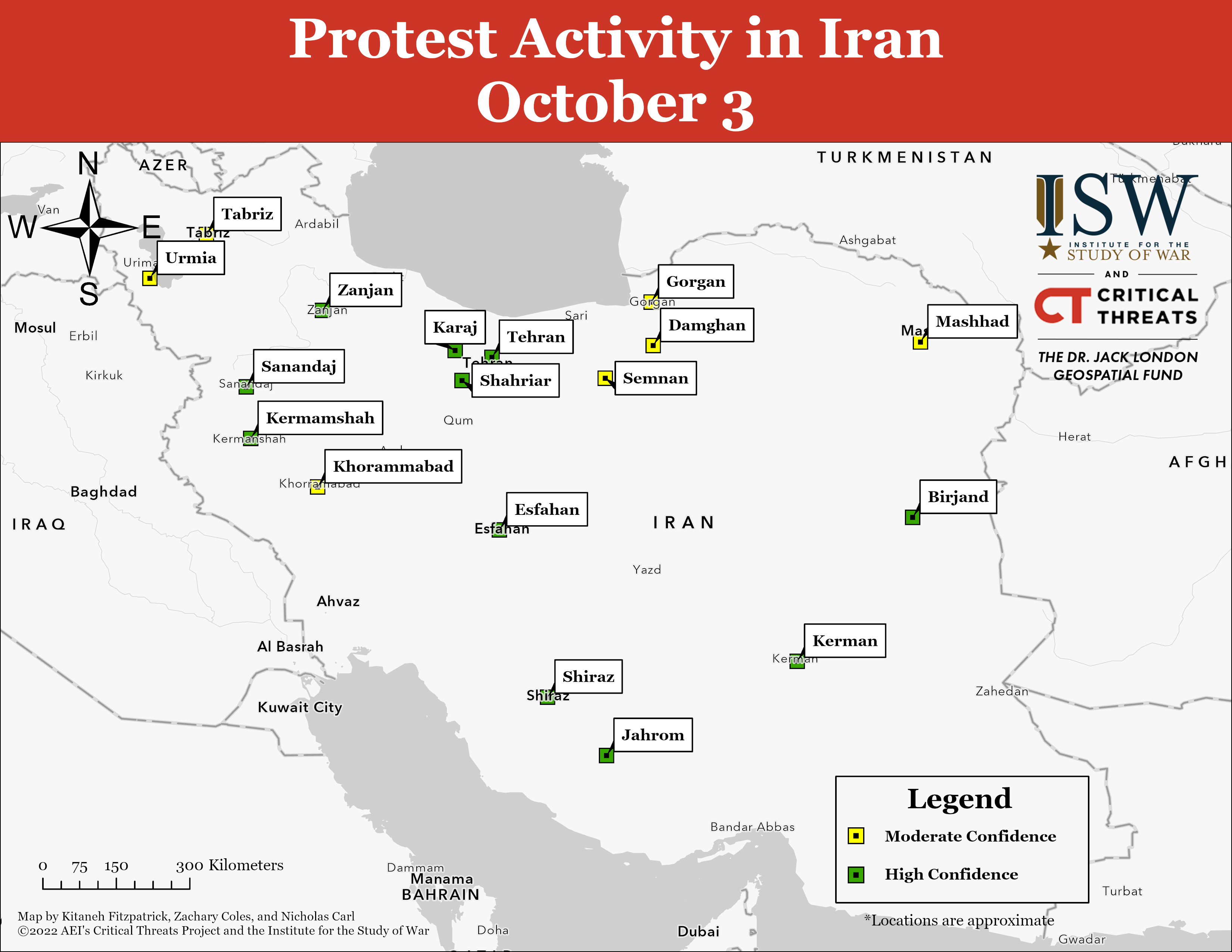 Iran Crisis Update, October 3 Nicholas Carl, Kitaneh Fitzpatrick, Zachary Coles, and Frederick W. Kagan October 3, 3:00 pm ET The Iran Crisis Updates are produced by the Critical Threats Project (CTP) at the American Enterprise Institute with support from the Institute for the Study of War (ISW). Supreme Leader Ali Khamenei made his first public appearance since September 21.[1] He spoke to a military officer graduation ceremony alongside the regime’s most senior military leaders. Khamenei appeared in stable condition during his speech. Khamenei condemned the ongoing, anti-regime protests during his speech—his first public acknowledgment of the protests. Khamenei accused the US and Israel of stoking the protests and said that the greatest victims were the state security services “and the Iranian nation.” Khamenei honored the security personnel killed in the protests. Khamenei may have decided to meet the military leadership for his first address on the protests to signal his support for the security establis...
Iran Crisis Update, October 3 Nicholas Carl, Kitaneh Fitzpatrick, Zachary Coles, and Frederick W. Kagan October 3, 3:00 pm ET The Iran Crisis Updates are produced by the Critical Threats Project (CTP) at the American Enterprise Institute with support from the Institute for the Study of War (ISW). Supreme Leader Ali Khamenei made his first public appearance since September 21.[1] He spoke to a military officer graduation ceremony alongside the regime’s most senior military leaders. Khamenei appeared in stable condition during his speech. Khamenei condemned the ongoing, anti-regime protests during his speech—his first public acknowledgment of the protests. Khamenei accused the US and Israel of stoking the protests and said that the greatest victims were the state security services “and the Iranian nation.” Khamenei honored the security personnel killed in the protests. Khamenei may have decided to meet the military leadership for his first address on the protests to signal his support for the security establis... -
ISW Blog - 03:14 Oct 03, 2022
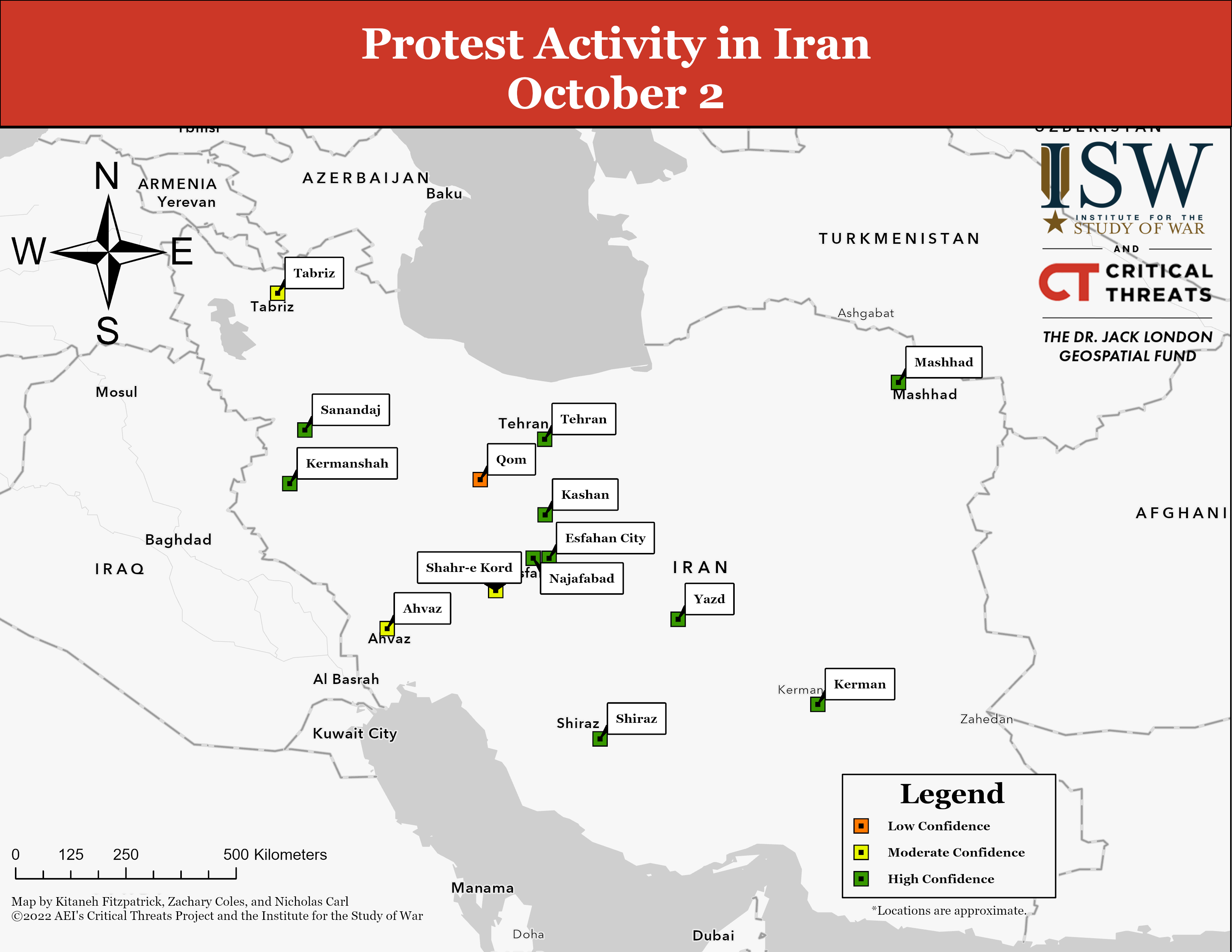 Nicholas Carl, Kitaneh Fitzpatrick, Zachary Coles, and Frederick W. Kagan October 2, 5:00 pm ET The Iran Crisis Updates are produced by the Critical Threats Project (CTP) at the American Enterprise Institute with support from the Institute for the Study of War (ISW). The continued public absence of Supreme Leader Ali Khamenei may be hindering regime officials’ efforts to develop a coherent response to the ongoing, anti-regime protests. Khamenei has not addressed the protests nor made a public appearance since September 21, possibly due to his reportedly worsening health.[1] An unidentified Iranian official told Reuters that intra-regime disagreements over supreme leader succession and protest management are dividing the regime elite.[2] This division suggests that Khamenei is not playing his usual role of cohering the regime during a crisis. Khamenei’s silence may have opened a leadership vacuum that other regime authorities are having to fill. Islamic Revolutionary Guards Corps (IRGC) leaders struck a mo...
Nicholas Carl, Kitaneh Fitzpatrick, Zachary Coles, and Frederick W. Kagan October 2, 5:00 pm ET The Iran Crisis Updates are produced by the Critical Threats Project (CTP) at the American Enterprise Institute with support from the Institute for the Study of War (ISW). The continued public absence of Supreme Leader Ali Khamenei may be hindering regime officials’ efforts to develop a coherent response to the ongoing, anti-regime protests. Khamenei has not addressed the protests nor made a public appearance since September 21, possibly due to his reportedly worsening health.[1] An unidentified Iranian official told Reuters that intra-regime disagreements over supreme leader succession and protest management are dividing the regime elite.[2] This division suggests that Khamenei is not playing his usual role of cohering the regime during a crisis. Khamenei’s silence may have opened a leadership vacuum that other regime authorities are having to fill. Islamic Revolutionary Guards Corps (IRGC) leaders struck a mo... -
ISW Blog - 03:13 Oct 03, 2022
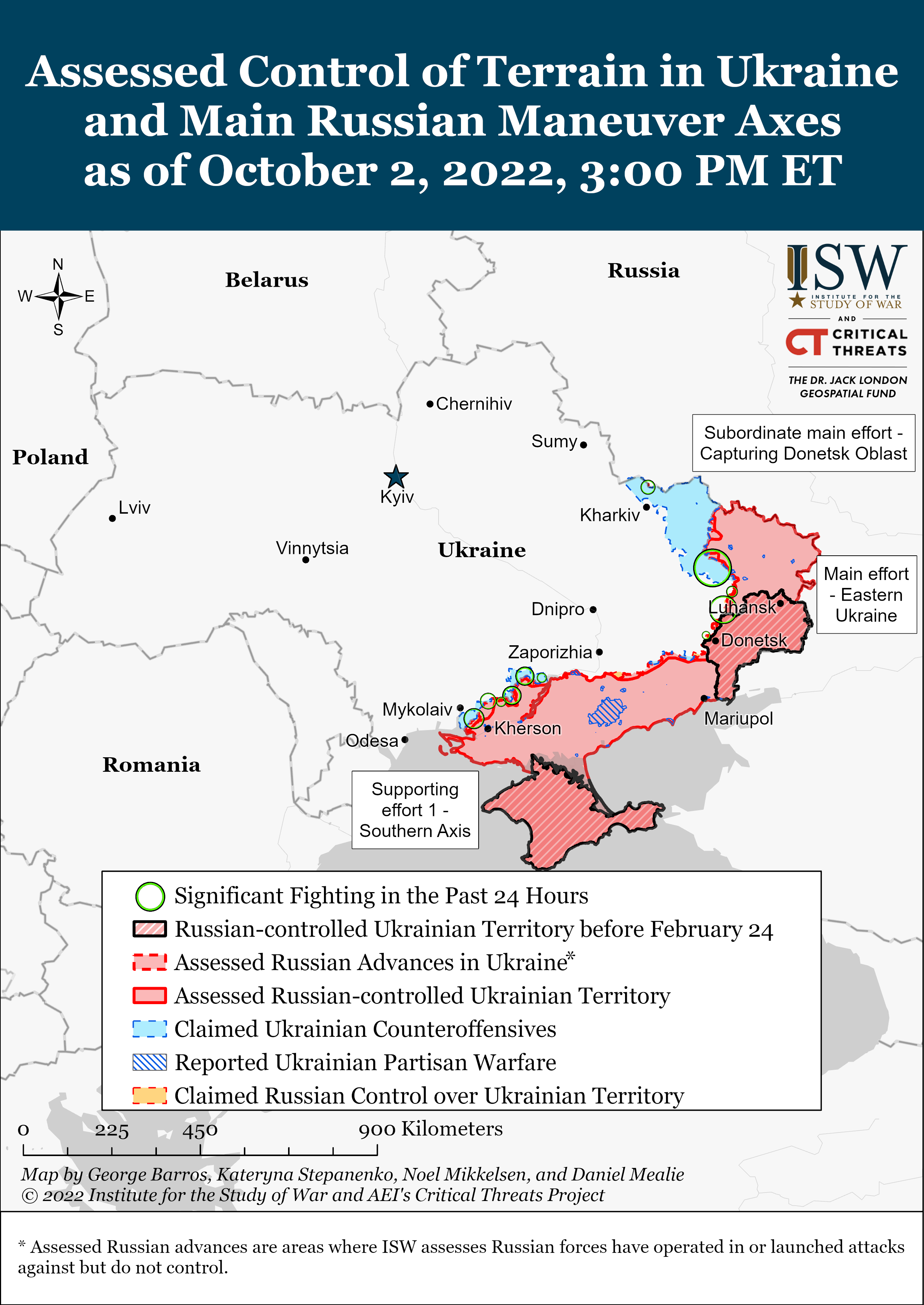 Special Edition on Russian Information Space Following the Defeat in Lyman Kateryna Stepanenko and Frederick W. Kagan October 2, 10:15 pm ET Click here to see ISW’s interactive map of the Russian invasion of Ukraine. This map is updated daily alongside the static maps present in this report. This campaign assessment special edition focuses on dramatic changes in the Russian information space following the Russian defeat around Lyman and in Kharkiv Oblast and amid the failures of Russia’s partial mobilization. Ukrainian forces made continued gains around Lyman, Donetsk Oblast, and have broken through Russian defensive positions in northeastern Kherson Oblast. Those developments are summarized briefly and will be covered in more detail tomorrow when more confirmation is available. The Russian defeat in Kharkiv Oblast and Lyman, combined with the Kremlin’s failure to conduct partial mobilization effectively and fairly are fundamentally changing the Russian information space. Kremlin-sponsored media and Russian...
Special Edition on Russian Information Space Following the Defeat in Lyman Kateryna Stepanenko and Frederick W. Kagan October 2, 10:15 pm ET Click here to see ISW’s interactive map of the Russian invasion of Ukraine. This map is updated daily alongside the static maps present in this report. This campaign assessment special edition focuses on dramatic changes in the Russian information space following the Russian defeat around Lyman and in Kharkiv Oblast and amid the failures of Russia’s partial mobilization. Ukrainian forces made continued gains around Lyman, Donetsk Oblast, and have broken through Russian defensive positions in northeastern Kherson Oblast. Those developments are summarized briefly and will be covered in more detail tomorrow when more confirmation is available. The Russian defeat in Kharkiv Oblast and Lyman, combined with the Kremlin’s failure to conduct partial mobilization effectively and fairly are fundamentally changing the Russian information space. Kremlin-sponsored media and Russian... -
ISW Blog - 00:51 Oct 02, 2022
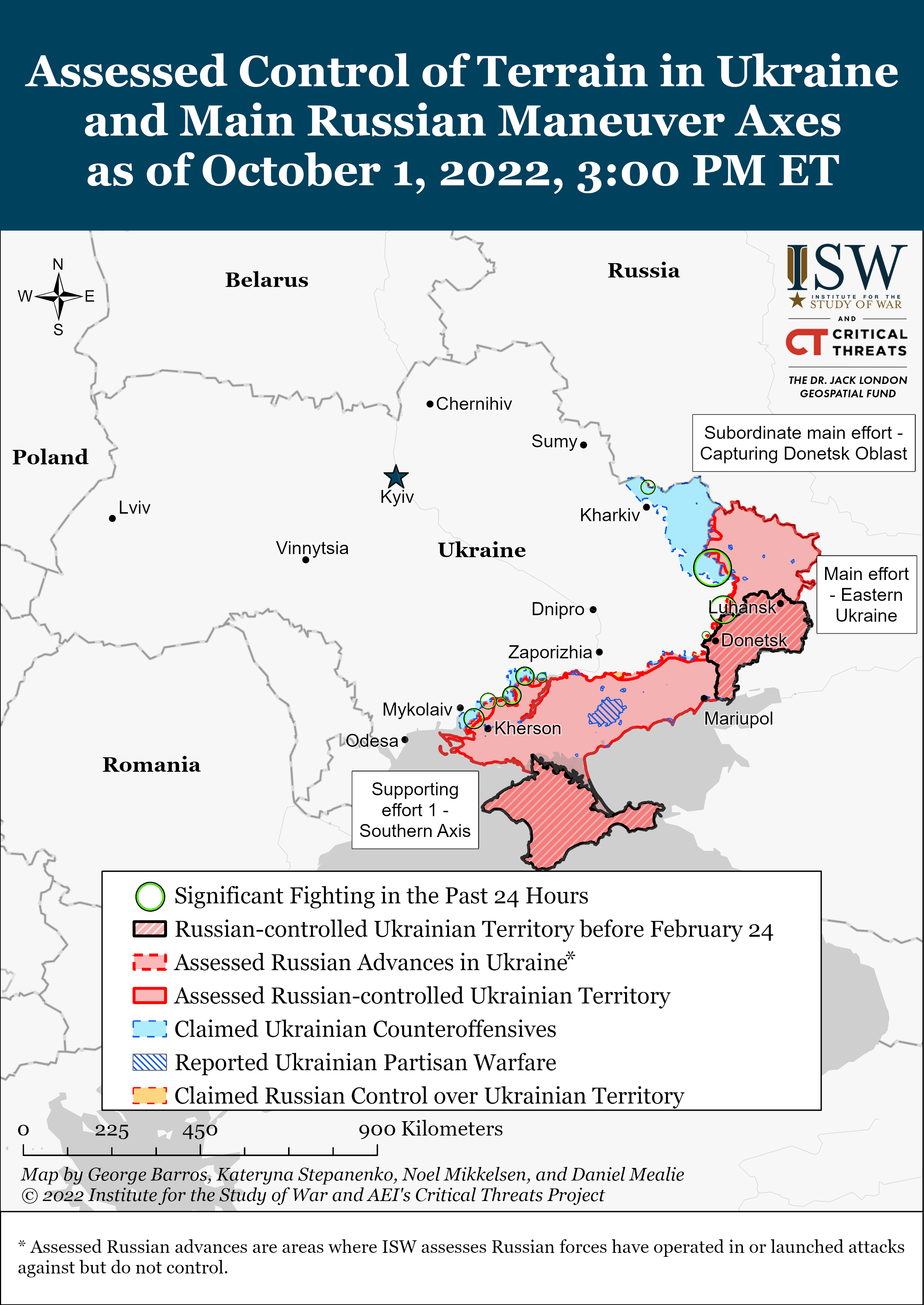 Kateryna Stepanenko, Karolina Hird, Grace Mappes, and Frederick W. Kagan October 1, 7 pm ET Click here to see ISW’s interactive map of the Russian invasion of Ukraine. This map is updated daily alongside the static maps present in this report. Ukrainian forces inflicted another significant operational defeat on Russia and liberated Lyman, Donetsk Oblast, on October 1. The Russian Ministry of Defense (MoD) announced the withdrawal of Russian troops from Lyman to “more advantageous positions” to avoid the “threat of encirclement” in the settlement.[1] Social media footage and Ukrainian military officials confirmed that Ukrainian forces have entered Lyman and are likely clearing the settlement as of October 1. The Russian information space – composed of Kremlin propagandists, pundits, and milbloggers – registered the defeat as the result of the Russian military command’s failure to send reinforcements in a timely manner, while openly criticizing repeated bureaucratic failures during the mobilization.[2] Russi...
Kateryna Stepanenko, Karolina Hird, Grace Mappes, and Frederick W. Kagan October 1, 7 pm ET Click here to see ISW’s interactive map of the Russian invasion of Ukraine. This map is updated daily alongside the static maps present in this report. Ukrainian forces inflicted another significant operational defeat on Russia and liberated Lyman, Donetsk Oblast, on October 1. The Russian Ministry of Defense (MoD) announced the withdrawal of Russian troops from Lyman to “more advantageous positions” to avoid the “threat of encirclement” in the settlement.[1] Social media footage and Ukrainian military officials confirmed that Ukrainian forces have entered Lyman and are likely clearing the settlement as of October 1. The Russian information space – composed of Kremlin propagandists, pundits, and milbloggers – registered the defeat as the result of the Russian military command’s failure to send reinforcements in a timely manner, while openly criticizing repeated bureaucratic failures during the mobilization.[2] Russi... -
ISW Blog - 00:51 Oct 02, 2022
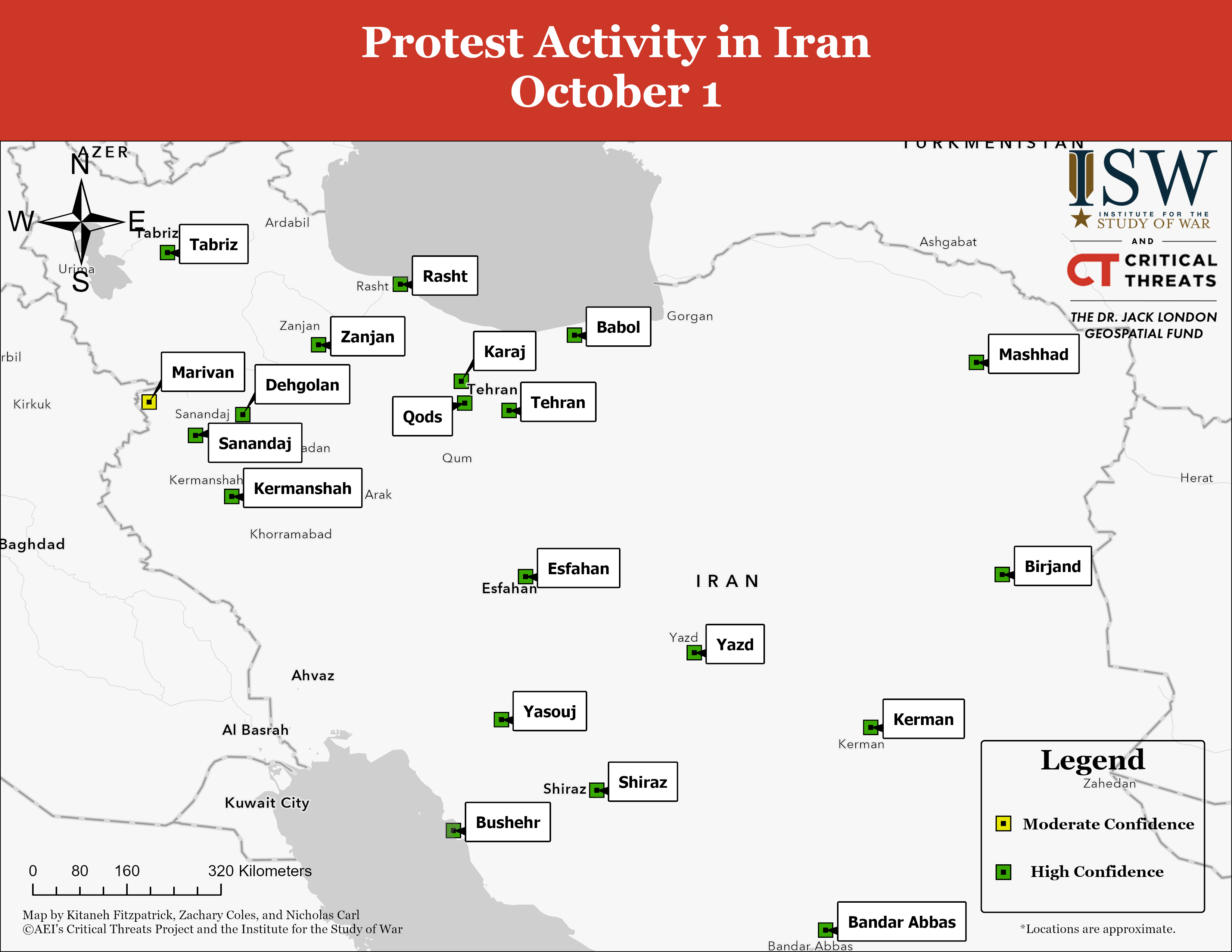 Nicholas Carl, Kitaneh Fitzpatrick, Zachary Coles, and Frederick W. Kagan October 1, 2:30 pm ET The Iran Crisis Updates are produced by the Critical Threats Project (CTP) at the American Enterprise Institute with support from the Institute for the Study of War (ISW). Iranian protesters successfully planned anti-regime demonstrations in at least 21 Iranian cities in 17 provinces on October 1 despite regime censorship. Protestors had announced plans over the past few days for protests on October 1 as CTP has previously reported.[i] The successful coordination of these demonstrations despite internet restrictions suggests that protesters—specifically university students—have found ways to organize. These protests pose a serious and increasing threat to the regime as their grievances resonate across a growing range of Iranians. These protests now include many marginalized minorities, merchants, students, and the urban elite. Protesters have found secular martyrs around whom to rally. Mahsa Amini is the most prom...
Nicholas Carl, Kitaneh Fitzpatrick, Zachary Coles, and Frederick W. Kagan October 1, 2:30 pm ET The Iran Crisis Updates are produced by the Critical Threats Project (CTP) at the American Enterprise Institute with support from the Institute for the Study of War (ISW). Iranian protesters successfully planned anti-regime demonstrations in at least 21 Iranian cities in 17 provinces on October 1 despite regime censorship. Protestors had announced plans over the past few days for protests on October 1 as CTP has previously reported.[i] The successful coordination of these demonstrations despite internet restrictions suggests that protesters—specifically university students—have found ways to organize. These protests pose a serious and increasing threat to the regime as their grievances resonate across a growing range of Iranians. These protests now include many marginalized minorities, merchants, students, and the urban elite. Protesters have found secular martyrs around whom to rally. Mahsa Amini is the most prom... -
ISW Blog - 01:07 Oct 01, 2022
 Kateryna Stepanenko, Katherine Lawlor, Grace Mappes, Riley Bailey, George Barros, and Frederick W. Kagan September 30, 8:30 pm ET Click here to see ISW’s interactive map of the Russian invasion of Ukraine. This map is updated daily alongside the static maps present in this report. Russian President Vladimir Putin did not threaten an immediate nuclear attack to halt the Ukrainian counteroffensives into Russian-occupied Ukraine during his speech announcing Russia’s illegal annexation of Ukrainian territory. ISW analysts broke down Putin’s speech in a separate September 30 Special Report: “Assessing Putin’s Implicit Nuclear Threats after Annexation.” Russian President Vladimir Putin announced the illegal Russian annexation of four Ukrainian territories on September 30 without clearly defining the borders of those claimed territories. Kremlin spokesperson Dmitry Peskov declined to specify the borders of the newly annexed territories in a September 30 conversation with reporters: "[the] Donetsk and Luhansk People'...
Kateryna Stepanenko, Katherine Lawlor, Grace Mappes, Riley Bailey, George Barros, and Frederick W. Kagan September 30, 8:30 pm ET Click here to see ISW’s interactive map of the Russian invasion of Ukraine. This map is updated daily alongside the static maps present in this report. Russian President Vladimir Putin did not threaten an immediate nuclear attack to halt the Ukrainian counteroffensives into Russian-occupied Ukraine during his speech announcing Russia’s illegal annexation of Ukrainian territory. ISW analysts broke down Putin’s speech in a separate September 30 Special Report: “Assessing Putin’s Implicit Nuclear Threats after Annexation.” Russian President Vladimir Putin announced the illegal Russian annexation of four Ukrainian territories on September 30 without clearly defining the borders of those claimed territories. Kremlin spokesperson Dmitry Peskov declined to specify the borders of the newly annexed territories in a September 30 conversation with reporters: "[the] Donetsk and Luhansk People'... -
ISW Blog - 00:24 Oct 01, 2022
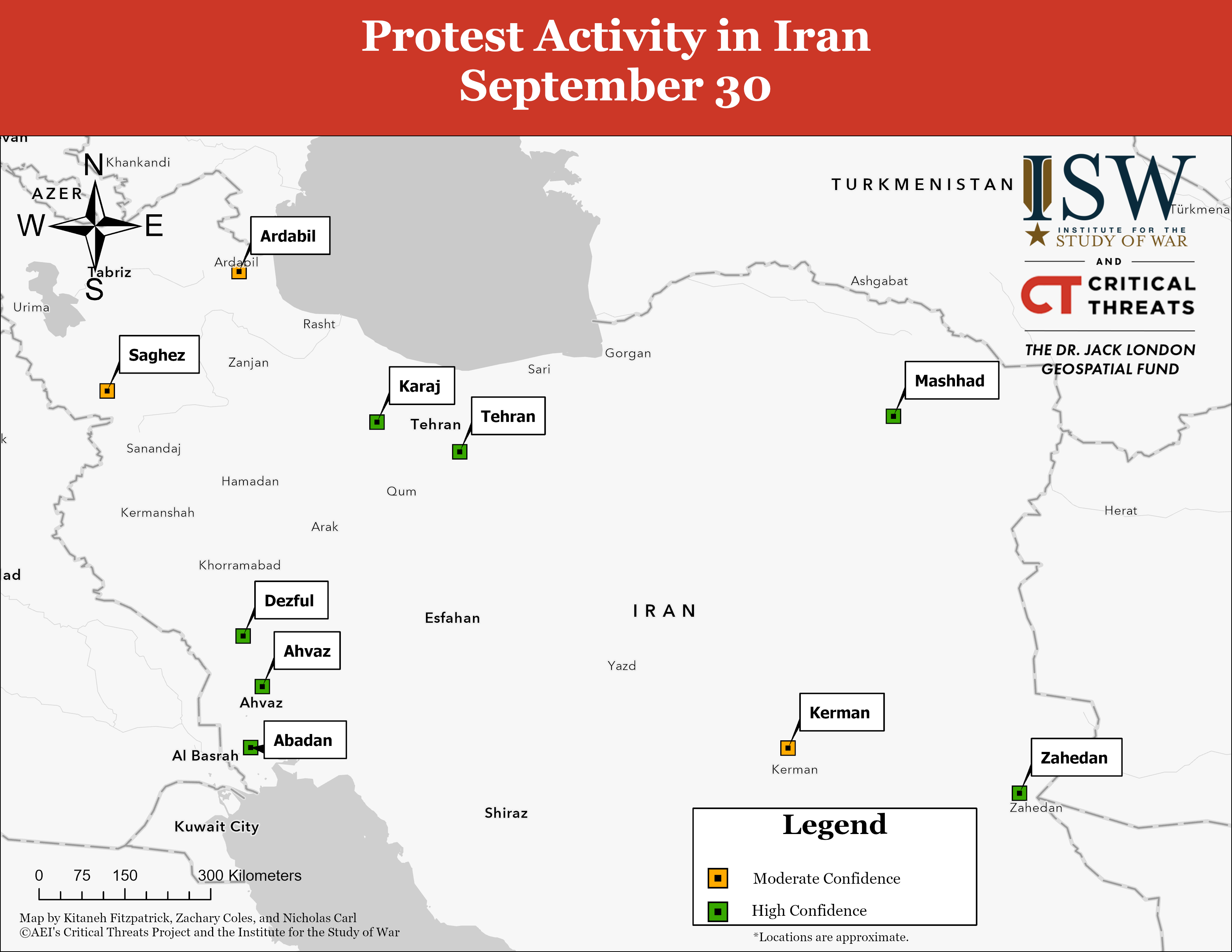 Nicholas Carl, Kitaneh Fitzpatrick, Zachary Coles, and Frederick W. Kagan September 30, 5:00 pm ET The Iran Crisis Updates are produced by the Critical Threats Project (CTP) at the American Enterprise Institute with support from the Institute for the Study of War (ISW). Anti-regime protests are continuing in at least 10 major cities in eight provinces and escalated violently in southeastern Sistan and Baluchistan Province on September 30. Protesters clashed with security forces in Zahedan, Sistan and Baluchistan Province, attacking local police stations and killing the provincial head of Islamic Revolutionary Guards Corps (IRGC) intelligence.[1] Social media users suggested that state security services deployed helicopters to abet their crackdown.[2] These clashes are among the most violent in the ongoing protest wave thus far. The security situation around Zahedan could worsen in the coming days and weeks, straining state security services more than they already are. Anti-regime militancy is common around Za...
Nicholas Carl, Kitaneh Fitzpatrick, Zachary Coles, and Frederick W. Kagan September 30, 5:00 pm ET The Iran Crisis Updates are produced by the Critical Threats Project (CTP) at the American Enterprise Institute with support from the Institute for the Study of War (ISW). Anti-regime protests are continuing in at least 10 major cities in eight provinces and escalated violently in southeastern Sistan and Baluchistan Province on September 30. Protesters clashed with security forces in Zahedan, Sistan and Baluchistan Province, attacking local police stations and killing the provincial head of Islamic Revolutionary Guards Corps (IRGC) intelligence.[1] Social media users suggested that state security services deployed helicopters to abet their crackdown.[2] These clashes are among the most violent in the ongoing protest wave thus far. The security situation around Zahedan could worsen in the coming days and weeks, straining state security services more than they already are. Anti-regime militancy is common around Za... -
ISW Blog - 17:26 Sep 30, 2022
Mason Clark, Katherine Lawlor, and Kateryna Stepanenko September 30, 12:45pm ET Russian President Vladimir Putin did not threaten an immediate nuclear attack to halt the Ukrainian counteroffensives into Russian-occupied Ukraine during his speech announcing Russia’s illegal annexation of Ukrainian territory. Putin announced Russia’s illegal annexation of Ukraine’s Donetsk, Luhansk, Kherson, and Zaporizhia oblasts on September 30 even as Ukrainian forces encircled Russian troops in the key city of Lyman, Luhansk Oblast, immediately demonstrating that Russia will struggle to hold the territory it claims to have annexed. Putin likely intends annexation to freeze the war along the current frontlines and allow time for Russian mobilization to reconstitute Russian forces. The annexation of parts of four Ukrainian oblasts does not signify that Putin has abandoned his stated objective of destroying the Ukrainian state for a lesser goal. As ISW assessed in May, if Putin’s annexation of occupied Ukraine stabilizes the c... -
ISW Blog - 00:34 Sep 30, 2022
Kitaneh Fitzpatrick, Nicholas Carl, Zachary Coles, and Frederick W. Kagan September 29, 3:00 pm ET The Iran Crisis Updates are produced by the Critical Threats Project (CTP) at the American Enterprise Institute with support from the Institute for the Study of War (ISW). The Iranian regime’s extensive internet and telecommunications censorship is severely limiting the open-source information available on ongoing anti-regime protests in Iran. Iranian state media and officials have confirmed that they are blocking domestic access to Western social media applications such as WhatsApp and Instagram to impede protester coordination and organization and limit the free flow of information September 22.[1] Iranian internet users reported restricted access to foreign domains—including Google—and difficulties accessing Google Play and Apple’s App store, preventing users’ efforts to download VPNs.[2] CTP cannot verify most protest footage circulating on social media. Iranian authorities previously blocked internet acces...
-
ISW Blog - 00:33 Sep 30, 2022
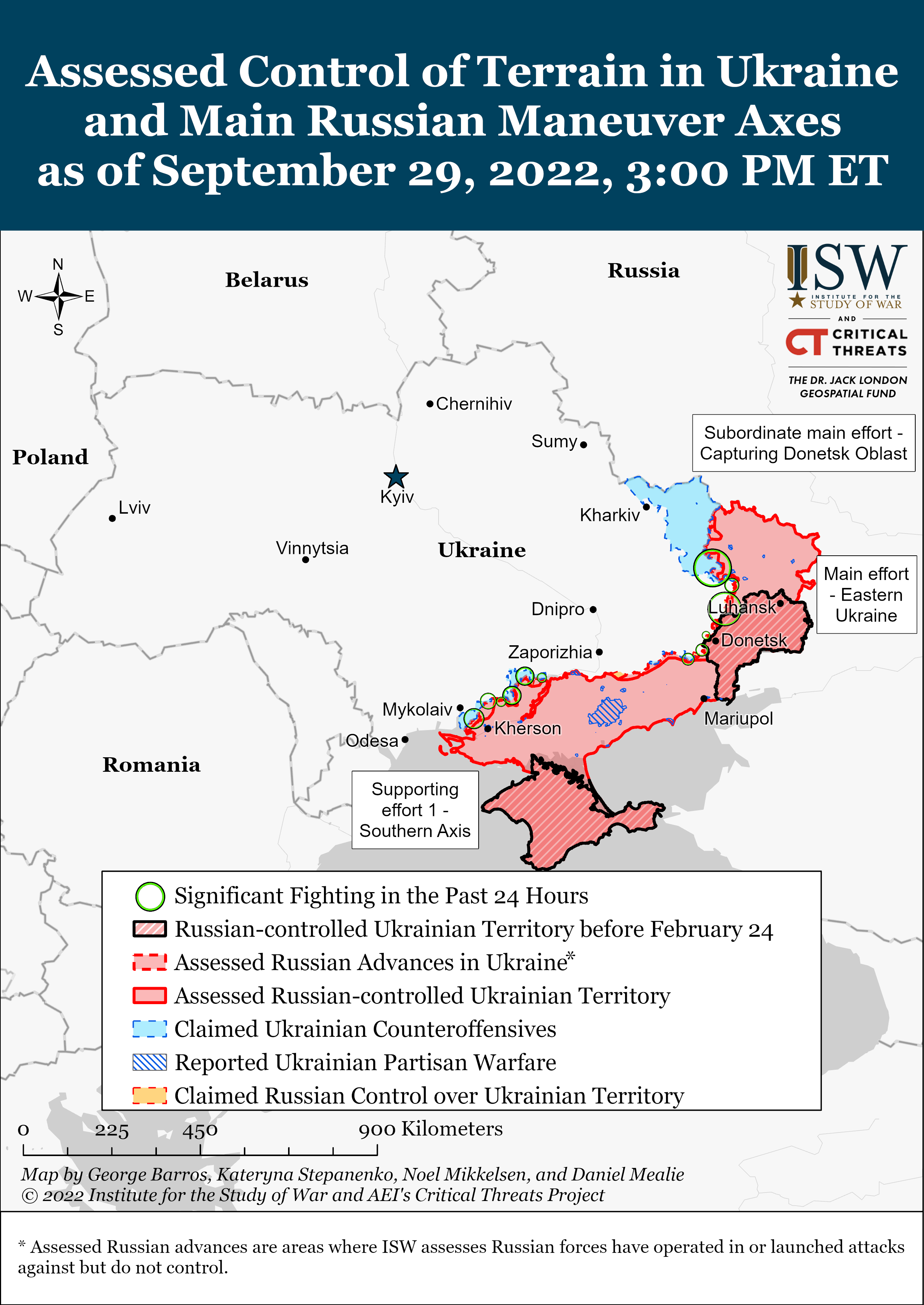 Kateryna Stepanenko, Karolina Hird, George Barros, Riley Bailey, and Frederick W. Kagan September 29, 7:30 pm ET Click here to see ISW’s interactive map of the Russian invasion of Ukraine. This map is updated daily alongside the static maps present in this report. The Kremlin continues to violate its stated “partial mobilization” procedures and contradict its own messaging even while recognizing the systematic failures within the Russian bureaucracy just eight days after the declaration of mobilization. Russian President Vladimir Putin acknowledged and deflected the blame for repeated “mistakes” during the first week of mobilization in his opening remarks at the Russian Security Council meeting on September 29.[1] Putin recounted instances of mobilizing men without prior military experience, assigning servicemen to the wrong specializations, and unfairly mobilizing men with health conditions or large families. ISW has previously reported that Kremlin-state media began exploring similar complaints just days ...
Kateryna Stepanenko, Karolina Hird, George Barros, Riley Bailey, and Frederick W. Kagan September 29, 7:30 pm ET Click here to see ISW’s interactive map of the Russian invasion of Ukraine. This map is updated daily alongside the static maps present in this report. The Kremlin continues to violate its stated “partial mobilization” procedures and contradict its own messaging even while recognizing the systematic failures within the Russian bureaucracy just eight days after the declaration of mobilization. Russian President Vladimir Putin acknowledged and deflected the blame for repeated “mistakes” during the first week of mobilization in his opening remarks at the Russian Security Council meeting on September 29.[1] Putin recounted instances of mobilizing men without prior military experience, assigning servicemen to the wrong specializations, and unfairly mobilizing men with health conditions or large families. ISW has previously reported that Kremlin-state media began exploring similar complaints just days ... -
ISW Blog - 03:45 Sep 29, 2022
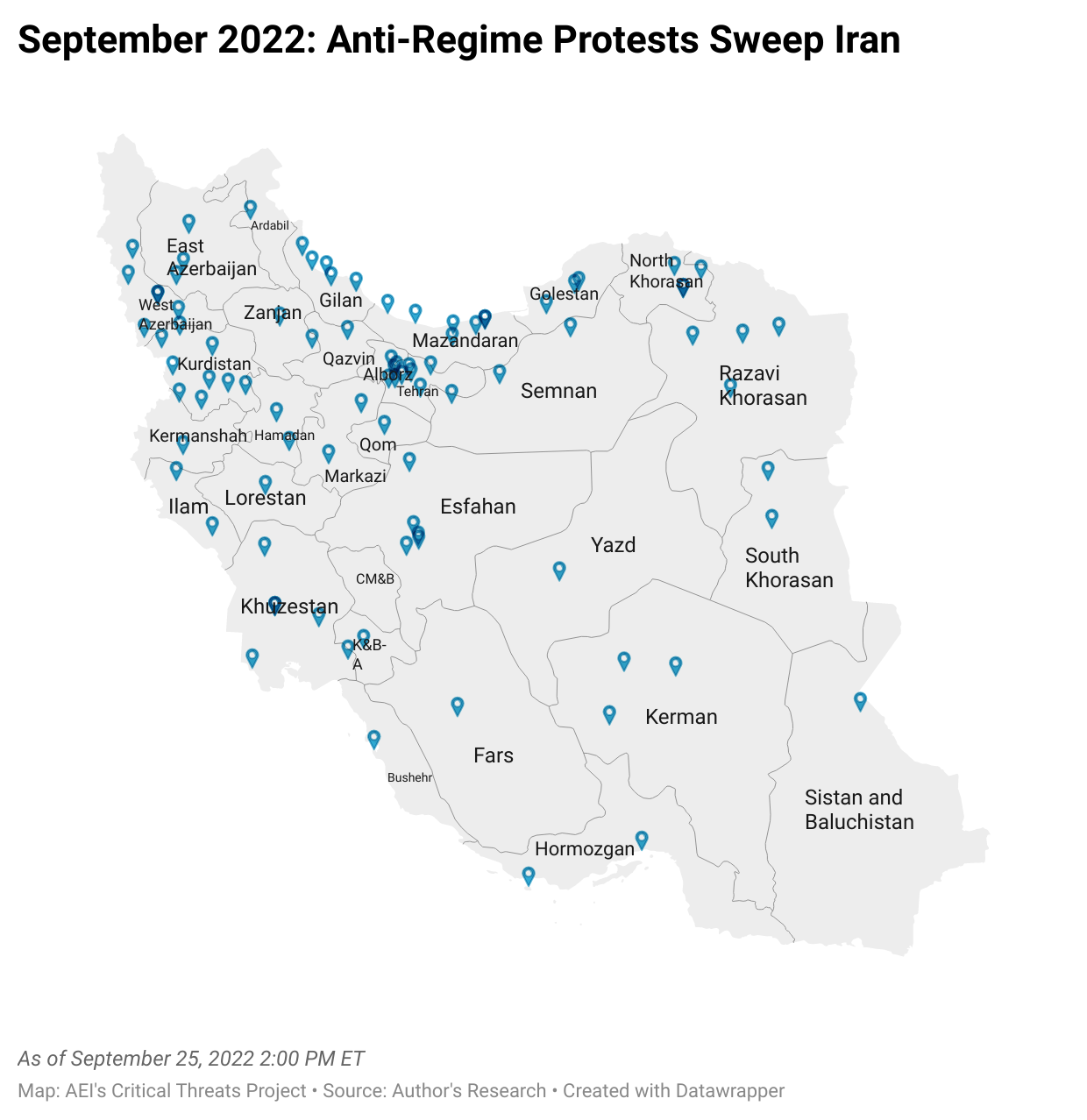 Nicholas Carl, Kitaneh Fitzpatrick, Zachary Coles, and Frederick W. Kagan September 28, 5:00 pm ET The Iran Crisis Updates are produced by the Critical Threats Project (CTP) at the American Enterprise Institute with support from the Institute for the Study of War (ISW). Circumstantial evidence suggests that Supreme Leader Ali Khamenei is at least temporarily unable to perform his normal duties. Khamenei has been unusually absent in recent days amidst countrywide, anti-regime protests, which began on September 16. Rumors have circulated that Khamenei’s health has deteriorated significantly since early September.[1] CTP cannot verify these rumors about Khamenei’s health, and such reports should be treated with skepticism. There are indications that Khamenei is ill or incapacitated, however. Regime power centers are behaving as if succession is either imminent or underway. President Ebrahim Raisi—a prominent frontrunner to succeed Khamenei—is positioning himself to become the next supreme leader with support fro...
Nicholas Carl, Kitaneh Fitzpatrick, Zachary Coles, and Frederick W. Kagan September 28, 5:00 pm ET The Iran Crisis Updates are produced by the Critical Threats Project (CTP) at the American Enterprise Institute with support from the Institute for the Study of War (ISW). Circumstantial evidence suggests that Supreme Leader Ali Khamenei is at least temporarily unable to perform his normal duties. Khamenei has been unusually absent in recent days amidst countrywide, anti-regime protests, which began on September 16. Rumors have circulated that Khamenei’s health has deteriorated significantly since early September.[1] CTP cannot verify these rumors about Khamenei’s health, and such reports should be treated with skepticism. There are indications that Khamenei is ill or incapacitated, however. Regime power centers are behaving as if succession is either imminent or underway. President Ebrahim Raisi—a prominent frontrunner to succeed Khamenei—is positioning himself to become the next supreme leader with support fro... -
ISW Blog - 00:04 Sep 29, 2022
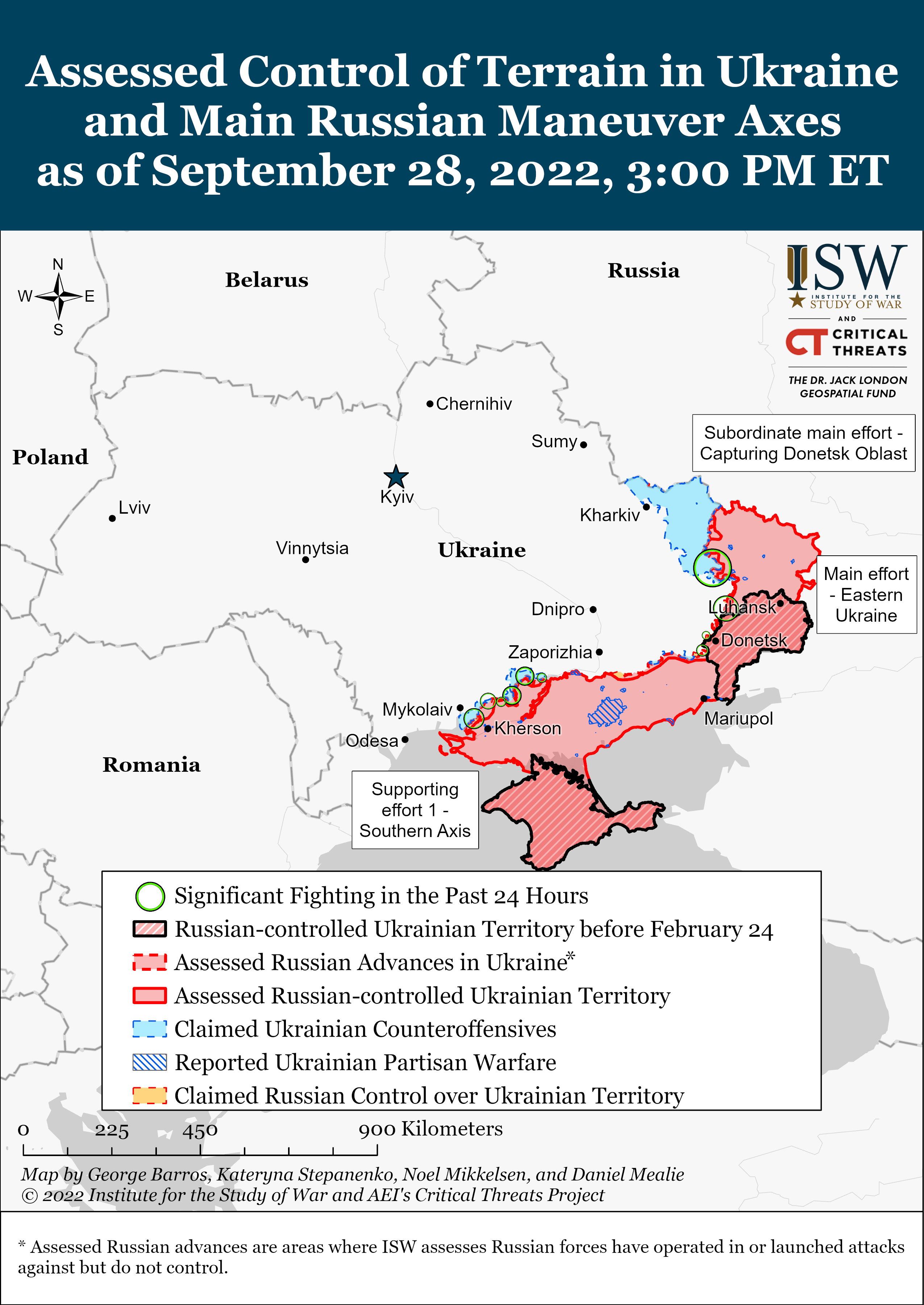 Karolina Hird, Katherine Lawlor, Grace Mappes, Riley Bailey, and Frederick W. Kagan September 28, 7:30pm ET Click here to see ISW’s interactive map of the Russian invasion of Ukraine. This map is updated daily alongside the static maps present in this report. Russian milbloggers discussed Ukrainian gains around Lyman with increased concern on September 28, suggesting that Russian forces in this area may face imminent defeat.[1] Several Russian milbloggers and prominent military correspondents claimed that Ukrainian troops advanced west, north, and northeast of Lyman and are working to complete the envelopment of Russian troops in Lyman and along the northern bank of the Siverskyi Donets River in this area.[2] Russian mibloggers stated that Ukrainian troops are threatening Russian positions and lines of communication that support the Lyman grouping. The collapse of the Lyman pocket will likely be highly consequential to the Russian grouping in northern Donetsk and western Luhansk oblasts and may allow Ukrai...
Karolina Hird, Katherine Lawlor, Grace Mappes, Riley Bailey, and Frederick W. Kagan September 28, 7:30pm ET Click here to see ISW’s interactive map of the Russian invasion of Ukraine. This map is updated daily alongside the static maps present in this report. Russian milbloggers discussed Ukrainian gains around Lyman with increased concern on September 28, suggesting that Russian forces in this area may face imminent defeat.[1] Several Russian milbloggers and prominent military correspondents claimed that Ukrainian troops advanced west, north, and northeast of Lyman and are working to complete the envelopment of Russian troops in Lyman and along the northern bank of the Siverskyi Donets River in this area.[2] Russian mibloggers stated that Ukrainian troops are threatening Russian positions and lines of communication that support the Lyman grouping. The collapse of the Lyman pocket will likely be highly consequential to the Russian grouping in northern Donetsk and western Luhansk oblasts and may allow Ukrai... -
ISW Blog - 01:28 Sep 28, 2022
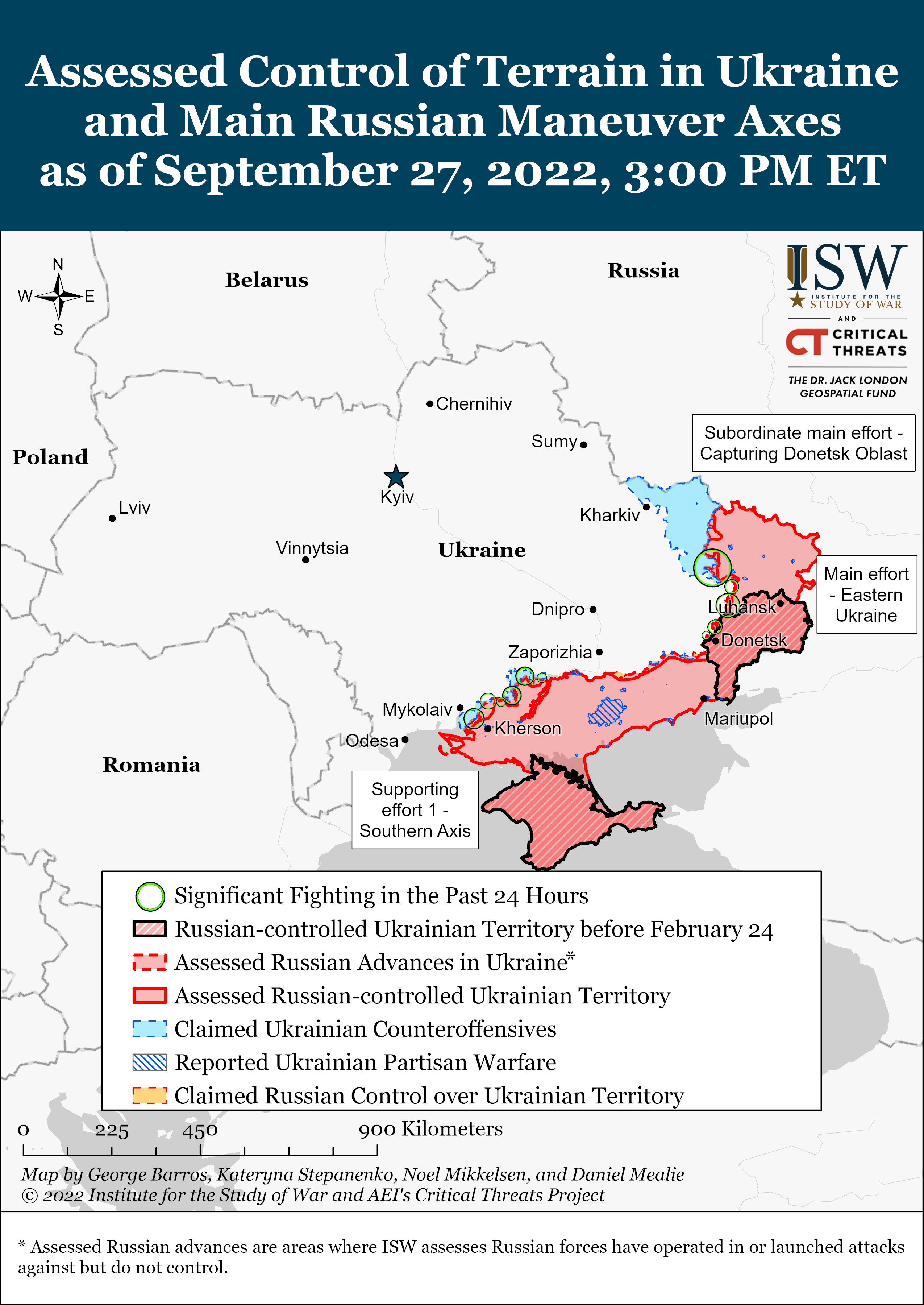 Kateryna Stepanenko, Katherine Lawlor, Grace Mappes, Riley Bailey, and Mason Clark September 27, 8:30pm ET Click here to see ISW’s interactive map of the Russian invasion of Ukraine. This map is updated daily alongside the static maps present in this report. Russian authorities in occupied parts of Ukraine’s Kherson, Zaporizhia, Donetsk, and Luhansk oblasts completed their falsified annexation “referenda” on September 27 and implausibly claimed that each sham referendum received between 87 and 99% approval from Ukrainian residents.[1] Russian officials pre-ordained and falsified the approval ratings and alleged voter participation rates for the sham referenda while coercing Ukrainian civilians in occupied territories to performatively vote for Russian annexation, as ISW has previously reported. Russian President Vladimir Putin will likely announce the Russian annexation of occupied Ukrainian territory on September 30. The completion of the performative referenda marks the last prerequisite for Russian Preside...
Kateryna Stepanenko, Katherine Lawlor, Grace Mappes, Riley Bailey, and Mason Clark September 27, 8:30pm ET Click here to see ISW’s interactive map of the Russian invasion of Ukraine. This map is updated daily alongside the static maps present in this report. Russian authorities in occupied parts of Ukraine’s Kherson, Zaporizhia, Donetsk, and Luhansk oblasts completed their falsified annexation “referenda” on September 27 and implausibly claimed that each sham referendum received between 87 and 99% approval from Ukrainian residents.[1] Russian officials pre-ordained and falsified the approval ratings and alleged voter participation rates for the sham referenda while coercing Ukrainian civilians in occupied territories to performatively vote for Russian annexation, as ISW has previously reported. Russian President Vladimir Putin will likely announce the Russian annexation of occupied Ukrainian territory on September 30. The completion of the performative referenda marks the last prerequisite for Russian Preside... -
ISW Blog - 04:34 Sep 27, 2022
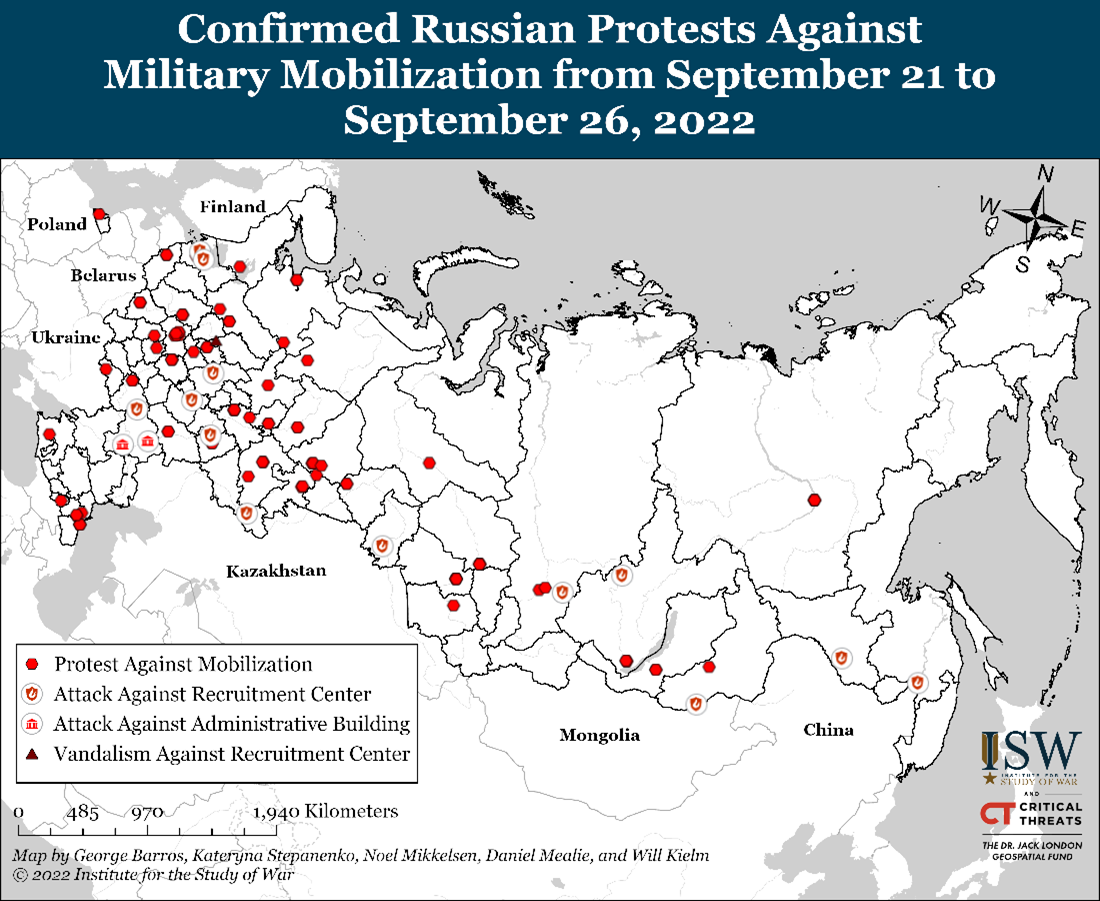 Kateryna Stepanenko, Katherine Lawlor, George Barros, Riley Bailey, and Frederick W. Kagan September 26, 11:25 pm ET Click here to see ISW’s interactive map of the Russian invasion of Ukraine. This map is updated daily alongside the static maps present in this report. The Kremlin is attempting to message its way out of the reality of major problems in the execution of its “partial mobilization,” but its narratives are unlikely to placate Russians who can perceive the real mistakes all around them. The Kremlin is deflecting blame for the Russian government’s failure to abide by its own stated criteria for mobilization and exemptions onto the failing bureaucratic institutions responsible for the mobilization. The Kremlin is downplaying the widespread violations of the mobilization law as individual errors of local authorities, claiming to correct these errors as citizens call attention to them. The violations are clearly too common to be merely the result of individual errors, however, and Russian citizens can ...
Kateryna Stepanenko, Katherine Lawlor, George Barros, Riley Bailey, and Frederick W. Kagan September 26, 11:25 pm ET Click here to see ISW’s interactive map of the Russian invasion of Ukraine. This map is updated daily alongside the static maps present in this report. The Kremlin is attempting to message its way out of the reality of major problems in the execution of its “partial mobilization,” but its narratives are unlikely to placate Russians who can perceive the real mistakes all around them. The Kremlin is deflecting blame for the Russian government’s failure to abide by its own stated criteria for mobilization and exemptions onto the failing bureaucratic institutions responsible for the mobilization. The Kremlin is downplaying the widespread violations of the mobilization law as individual errors of local authorities, claiming to correct these errors as citizens call attention to them. The violations are clearly too common to be merely the result of individual errors, however, and Russian citizens can ... -
ISW Blog - 00:17 Sep 26, 2022
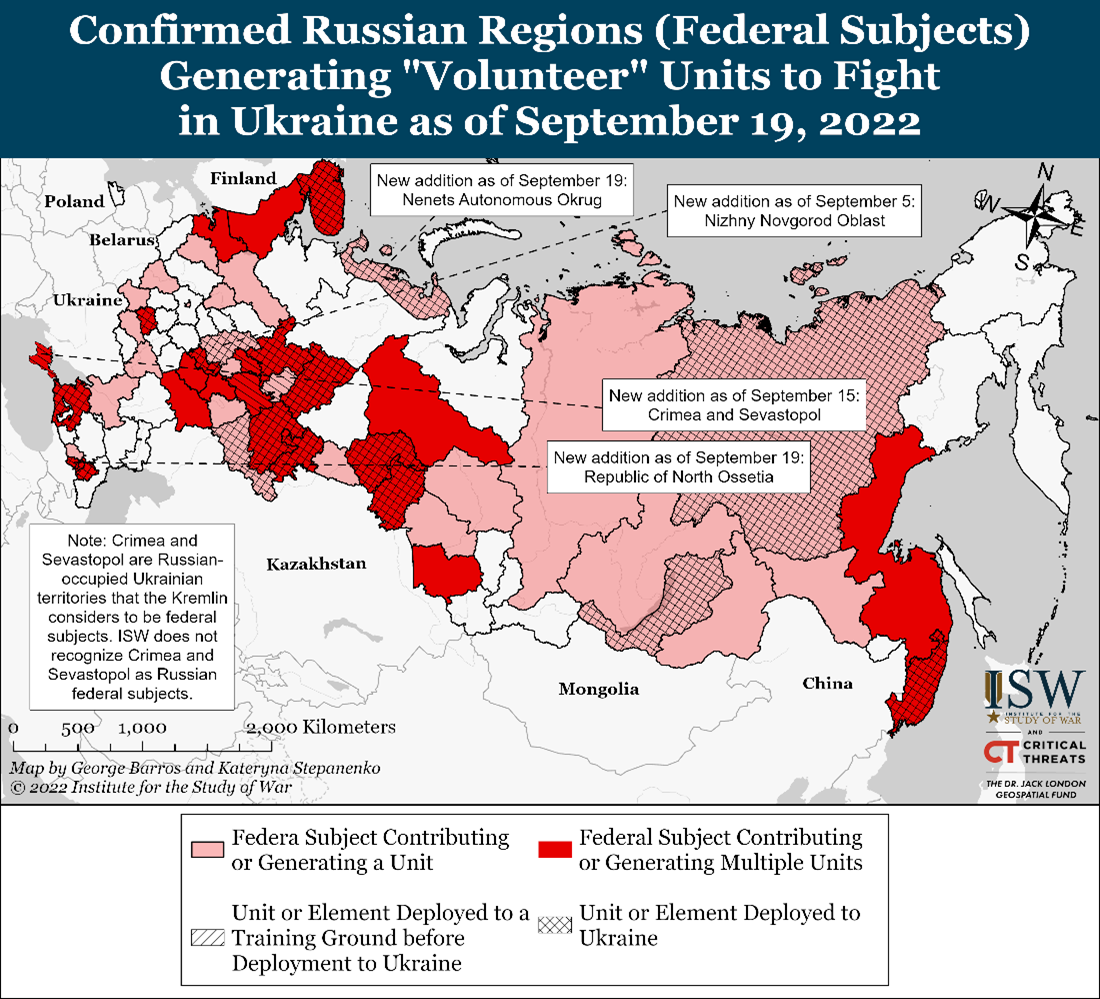 Special Edition on Russian Mobilization Frederick W. Kagan September 25, 6 pm ET Click here to see ISW’s interactive map of the Russian invasion of Ukraine. This map is updated daily alongside the static maps present in this report. This campaign assessment special edition focuses on Russian military mobilization efforts. Significant inflections ISW would normally cover in its regular sections will be summarized briefly today and addressed in more detail tomorrow. Russian President Vladimir Putin is unlikely to overcome fundamental structural challenges in attempting to mobilize large numbers of Russians to continue his war in Ukraine. The “partial mobilization” he ordered on September 21 will generate additional forces but inefficiently and with high domestic social and political costs. The forces generated by this “partial mobilization,” critically, are very unlikely to add substantially to the Russian military’s net combat power in 2022. Putin will have to fix basic flaws in the Russian military personnel ...
Special Edition on Russian Mobilization Frederick W. Kagan September 25, 6 pm ET Click here to see ISW’s interactive map of the Russian invasion of Ukraine. This map is updated daily alongside the static maps present in this report. This campaign assessment special edition focuses on Russian military mobilization efforts. Significant inflections ISW would normally cover in its regular sections will be summarized briefly today and addressed in more detail tomorrow. Russian President Vladimir Putin is unlikely to overcome fundamental structural challenges in attempting to mobilize large numbers of Russians to continue his war in Ukraine. The “partial mobilization” he ordered on September 21 will generate additional forces but inefficiently and with high domestic social and political costs. The forces generated by this “partial mobilization,” critically, are very unlikely to add substantially to the Russian military’s net combat power in 2022. Putin will have to fix basic flaws in the Russian military personnel ... -
ISW Blog - 01:41 Sep 25, 2022
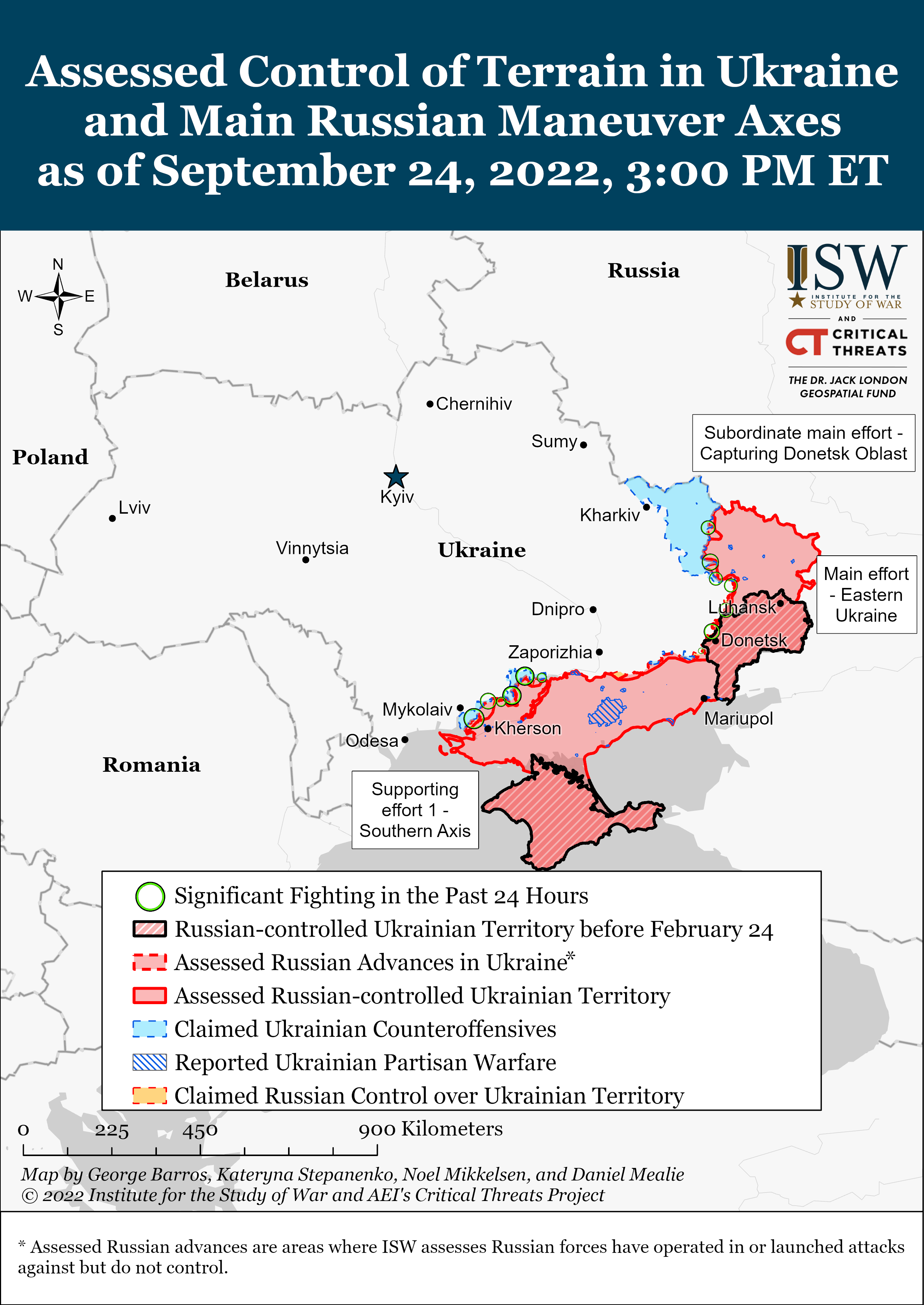 Karolina Hird, George Barros, and Frederick W. Kagan September 24, 9 pm ET Click here to see ISW’s interactive map of the Russian invasion of Ukraine. This map is updated daily alongside the static maps present in this report. Russian Defense Minister Sergei Shoigu’s declarations about which categories of Russian males will be exempted from partial mobilization may not reflect Russian President Vladimir Putin’s intentions or orders. A Russian media insider claimed on September 24 that officials of the Russian Ministry of Defense (MoD) reprimanded military commissars in person for negligence in carrying out mobilization and sending out summonses in “excess,” and contrary to the explicit MoD guidance regarding exemptions for age, disability, or other limiting factors.[1] Another Russian source claimed that certain heads of federal subjects acknowledged that they have mobilized citizens who are technically ineligible.[2] Responsibility for the partial mobilization appears to be divided and complex, possibly co...
Karolina Hird, George Barros, and Frederick W. Kagan September 24, 9 pm ET Click here to see ISW’s interactive map of the Russian invasion of Ukraine. This map is updated daily alongside the static maps present in this report. Russian Defense Minister Sergei Shoigu’s declarations about which categories of Russian males will be exempted from partial mobilization may not reflect Russian President Vladimir Putin’s intentions or orders. A Russian media insider claimed on September 24 that officials of the Russian Ministry of Defense (MoD) reprimanded military commissars in person for negligence in carrying out mobilization and sending out summonses in “excess,” and contrary to the explicit MoD guidance regarding exemptions for age, disability, or other limiting factors.[1] Another Russian source claimed that certain heads of federal subjects acknowledged that they have mobilized citizens who are technically ineligible.[2] Responsibility for the partial mobilization appears to be divided and complex, possibly co...